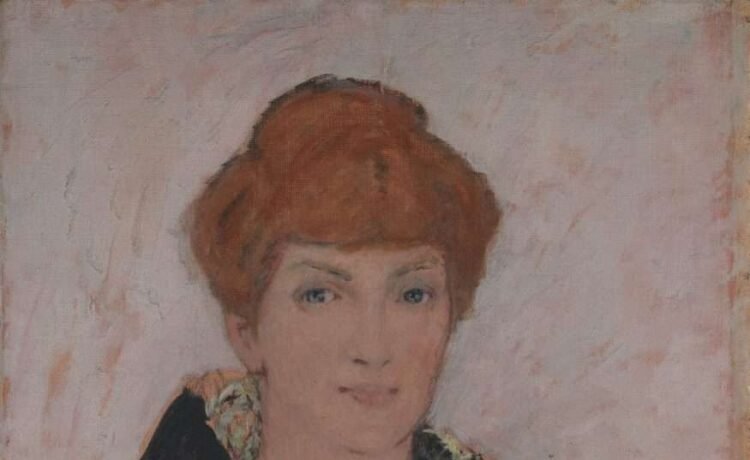
 Despite actively participating in art history, female artists tended to act in the shadow of their male contemporaries.
Despite actively participating in art history, female artists tended to act in the shadow of their male contemporaries.
For well into the twentieth century, they were excluded from art schools, galleries and museums. Therefore, few platforms for the exhibition of their work were available.
Although these were considerable obstacles, they did not prevent female artists and patrons from playing a vital role in the introduction of modern art in America, in the founding of some of its major museums, and in the transfer of the avant-garde from Paris to New York.
The inspirational figure of Katherine Sophie Dreier stood at the vanguard of these developments.
Art & Engagement
Born in September 1877 in a Brooklyn brownstone house into a prosperous German family of immigrants descending from Bremen, Katherine’s liberal and socially engaged parents encouraged their youngest child’s creative nature and interest in art.
From 1895 to 1897 she attended the Brooklyn Art Students League and spent a year at Brooklyn’s Pratt Institute in 1900/1, a private college founded in 1887 with a curriculum that was concentrated on engineering, architecture and the fine arts.
She became financially independent following receipt of an inheritance after the death of her parents in the late 1890s.
In 1902 she traveled to Europe to study the Old Masters but encountered modernist painting when she viewed the splendid art collection of Leo and Gertrude Stein in Paris.
She felt attracted to and inspired by young artists who rejected the authority of Academic pictorial traditions, celebrating freedom of expression instead.
Dreier joined the rule breakers. Returning to New York City two years later, she arranged for private lessons with the Scottish-American painter Walter Shirlaw, co-founder and first President of the liberal Society of American Artists.
In 1905 she sold her first work of art, an altar painting for the chapel of Saint Paul’s school in Garden City, on Long Island.
Four years later she moved to London, settling in Chelsea, the capital’s artistic hub and former home to Oscar Wilde (the author lived in Tite Street as did the American painters James Singer Sargent, James McNeill Whislet and Orrin Peck).
Here she developed her passion as a collector. Dreier built a fine collection of Oscar Wilde’s printed works, manuscripts and letters which she would later bequeath to Yale University as part of her outstanding library.
Dreier’s first solo exhibition in America was held in October 1913 in the Macbeth Gallery at 11 East 57th Street. The first gallery in New York to specialize in American art, Macbeth would later be associated with the rise of the “angry” young men of the Ashcan School.

 That same year she exhibited two oil paintings at the spectacular Armory show that introduced modern art to New York and America, including “Woman Holding a Blue Bowl” (1911).
That same year she exhibited two oil paintings at the spectacular Armory show that introduced modern art to New York and America, including “Woman Holding a Blue Bowl” (1911).
The excitement of the event and the negative critical response to the show inspired her to dedicate her working life to creating, collecting and championing modern art and artists.
In 1916 Dreier joined the Society of Independent Artists. Following the example of the Société des Artistes Indépendants that had been active in Paris since July 1884, the society aimed at organizing annual exhibitions by avant-garde artists, the first of which took place in April/May 1917 at the Grand Central Palace, Lexington Avenue, where a staggering number of over 2,000 works of art were put on show (hung in alphabetical order by the artist’s last name).
This close circle of artists and patrons regularly met at the Manhattan apartment of the poet and collector Walter Conrad Arensberg at 33 West 67th Street.
It was in this company that Katherine met Marcel Duchamp (1887-1968) with whom she forged a lifelong platonic friendship and collaborative partnership.

 By that time, she had become known for her abstract paintings consisting of layered geometric forms of which her “Portrait of Marcel Duchamp” (1918) is a celebrated example.
By that time, she had become known for her abstract paintings consisting of layered geometric forms of which her “Portrait of Marcel Duchamp” (1918) is a celebrated example.
Dreier coupled esthetics with her role as a social activist and feminist. She acted as treasurer of the German Home for Recreation for Women and Children, founded by her mother (1900); she was co-founder and president of the Little Italy Neighborhood Association, Brooklyn (1905); served as a delegate at the sixth convention of the International Woman’s Suffrage Alliance (1911); and headed the New York’s German-American Committee of the Woman Suffrage Party (1915).
She was a fully engaged artist.
Société Anonyme
In 1920 Dreier and Duchamp teamed up with Man Ray in founding the pioneering Société Anonyme, Inc. with the intention to collect and promote modern art from Europe and the United States. Its first gallery was a brownstone located at 19 East 47th Street.
Its founders outlined a pedagogical program, organizing and sponsoring lectures, publications and exhibitions. Over time, they issued forty artists’ catalogues and Dreier’s own book Western Art in the New Era was published by the Society in 1923.
The Société built up the first permanent collection of modern art in the United States in which 175 artists were represented in more than eight hundred works.
Between 1920 and 1940, it held eighty exhibitions, showing mostly Cubist and abstract art (Paul Klee, Vassily Kandinky, Kazimir Malevich, Joan Miró, Fernand Léger, and many others) and introducing an American audience to the little-known creations of Piet Mondrian and Kurt Schwitters.
The name of the society was picked by Man Ray. Focusing on the work of art itself and not the personality of the creator, the moniker “Société Anonyme” seemed perfectly suitable for the undertaking with an element of Dadaist (anarchistic) absurdity added to it. The phrase translates as “Corporation” – making it in English translation ‘Corporation, Inc.’.
In 1926/7, the Société Anonyme put on America’s first survey of post-war international art at the Brooklyn Museum, three years before the New York’s Museum of Modern Art (MoMA) came into existence.
The well-attended “International Exhibition of Modern Art” was a comprehensive overview of the European avant-garde in which Dreier and her associates (including Kandinsky) made the ground-breaking choice to display the paintings in a horizontal line at eye level as opposed to the stacking of work that was customary in previous exhibitions and shows.
Membership fluctuated through the three decades of its existence (Man Ray who had acted as Secretary left after a year). Dreier was and remained the driving force behind the organization through her relentless energy, financial support and promotional efforts.
As time went by, the Société became increasingly a one-woman operation. Katherine’s idealism never dwindled, but her financial backing did. Lack of funds prevented her from finding much needed larger exhibition spaces.

 In 1928 she was forced to close the society’s headquarters, but she continued to stage events and accumulate work of art.
In 1928 she was forced to close the society’s headquarters, but she continued to stage events and accumulate work of art.
Dreier’s activities lasted until 1941 when the Society’s collections were handed to the Yale University Art Gallery. In 1950 Duchamp and Dreier published a catalogue of works donated to Yale.
On April 30th that same year, the thirtieth anniversary of the Society’s very first exhibition, Dreier and Duchamp hosted a dinner at the New Haven Lawn Club, close to Yale University, where they formally dissolved the organization.
The Société claimed credit for having created the first museum anywhere in the world that was exclusively devoted to the promotion of modern art.
Museum of Modern Art
The Société Anonyme’s subtitle “Museum of Modern Art” was a challenge to those who were involved in cultural studies at the time. The museum as a public institution was a relatively modern concept and numerous critics were either uncertain or skeptical about its role and function.
The critical argument goes back to the foundation of the Louvre in Paris when Napoleon Bonaparte, in an act of deranged national pride, ransacked Antwerp Cathedral to fill the wall of the institution with a magnificent altarpiece by Peter Paul Rubens.
It became a prototype for the systematized art robberies that the French would carry out in other territories they occupied (especially during the Italian and Egyptian campaigns).
Opponents argued that museums were the creation of hoarders and wreckers. To divorce art from its social or religious environment and deposit an assemblage of mutually exclusive works in a single building, was considered a reckless act of vandalism.
To such commentators the idea of a “museum of modern art” was a contradiction. Any work of art destined for a museum was institutionalized even before its completion, being deprived of function, purpose or context.
The museum was a dumping ground. “Musées, cimetières!” Italian poet Filippo Tommaso Marinetti howled in his influential 1909 Futurist manifesto. A museum was the death chamber of artistic initiative.
Duchamp argued that works of art blossom and wither; they are mortal just like their creators. It cannot be justified that the dead have a hold over the living. He expressed qualms about the esthetic and social function of a museum.
Its institutional brief to classify collections for public edification in addition to the curator’s active role in the marketplace, robbed art of its social relevance.

 Duchamp’s contributed his 1912 painting “Nu descendant un escalier” (Nude Descending a Staircase) to the Armory Show. The work was lambasted by the critics which raised its status to a “succès à scandale.”
Duchamp’s contributed his 1912 painting “Nu descendant un escalier” (Nude Descending a Staircase) to the Armory Show. The work was lambasted by the critics which raised its status to a “succès à scandale.”
It made him America’s best-known and most notorious modernist. For the artist himself this sudden fame was a watershed moment that determined his career.
Reflecting on the artist’s social position, he felt that he was forced to make a choice. He could either be chasing fame and money; or go underground for the sake of artistic independence.
Marcel decided to stop treating art as a profession and try to find alternative ways of connecting with the socio-economic system in which careers were traced and reputations sustained.
For many years he stayed away from art manifestations and avoided showing his latest works in exhibitions. He managed their circulation on his own, restricting access to a close circle (cénacle) of friends and associates.
His association with Katherine Dreier flourished because their joint initiative established a museum without a permanent physical building; there was no hierarchy of holdings or works stashed away in storage vaults; no close association with certain artists at the expense of others.
Theirs was an “experimental museum.” The ideal was larger than any individual. Dreier and Duchamp succeeded in stoking widespread curiosity in modern art, thereby developing alternative ways of seeing and thinking, whilst opening new avenues for aspiring artists.
Thanks to them, American art museums tended to describe themselves first and foremost as educational institutions.
Read more about art history in New York.
Illustrations from above: Anne Goldthwaite’s “Portrait of Katherine S. Dreier,” 1915/6 (Yale University Art Gallery); Dreier’s “Woman Holding a Blue Bowl,” 1911 (shown at the 1913 Armory Show); Dreier’s “Abstract Portrait of Marcel Duchamp,” 1918 (Museum of Modern Art); The Société Anonyme and the Dreier Bequest (New Haven Yale University Art Gallery, 1984); and Duchamp’s “Nude Descending a Staircase, No. 2,” 1912 (Philadelphia Museum of Art).








Recent Comments